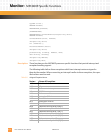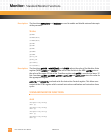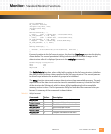
Monitor: Standard Monitor Functions
10002367-02 PmT1 and PmE1 User’s Manual
8-39
Table 8-7: IsLegal Function Types
If the character string contains legal characters, this function returns TRUE; otherwise, it
returns FALSE. The string equivalent of the character functions isalpha(), isupper(),
islower(), and isdigit() can be constructed from this function, which deals with the entire
string instead of a single character.
MemMng
void *Malloc(NumBytes)
unsigned long NumBytes;
void *Calloc(NumElements, Size)
unsigned long NumElements, Size;
Free(MemLoc)
unsigned long *MemLoc;
CFree(Block)
unsigned long *Block;
void *ReAlloc(Block, NumBytes)
char *Block;
unsigned long NumBytes;
MemReset()
MemAdd(MemAddr, MemSize)
unsigned long MemAddr, MemBSize;
MemStats()
Description: The memory management functions allocate and free memory from a memory pool. The
monitor initializes the memory pool to use all on-card memory after the monitor’s bss sec-
tion. If any of the autoboot features are used, the memory pool is not initialized and the
application program is required to set up the memory pool for these functions.
The functions Malloc, Calloc and ReAlloc allocate memory from the memory pool. Each of
these functions returns a pointer to the memory requested if the request can be satisfied
and NULL if there is not enough memory to satisfy the request. The function Malloc accepts
one argument, NumBytes, indicating the number of bytes requested. The function Calloc
accepts two arguments, NumElements and Size, indicating a request for a specified number
of elements of the specified size. The function ReAlloc reallocates a memory block by either
Type: Value: Legal Characters:
DECIMAL 0x8 0 - 9
HEX 0x4 0 - 9, A - F, a - f
UPPER 0x2 A - Z
LOWER 0x1 a - z
ALPHA 0x3 A - Z, a - z


















